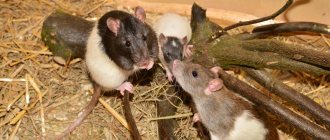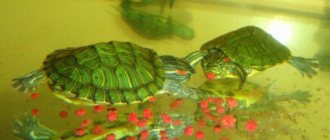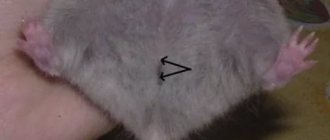Small, cheerful and intelligent rodents are an excellent choice for a pet. These include hamsters, guinea pigs and decorative rats. Some pet owners prefer to keep their animals one at a time. Others are interested in when animals have company or simply produce offspring, the characteristics of which can be influenced by choosing females and males. Breeding rats at home can be both an interesting hobby and a small income. But if you decide to start breeding rats and have acquired several animals, then it’s worth understanding all the intricacies of breeding these rodents.
Types of breeding
In domestic rats, two types of crossbreeding are possible: selection of different breeds and purebred breeding.
In turn, purebred crossing is divided into the following types:
- Linear crossing;
- Inbreeding;
- Outcrossing;
- Outbreeding.
Linebreeding
Linebreeding or line breeding of rats involves crossing individuals that have a common ancestor. This method allows you to obtain viable offspring with a good genotype. In this case, homozygosity is preserved, and characteristics that do not satisfy the breeder are leveled out.
Inbreeding
To consolidate important breed qualities, the inbreeding method is chosen. Breeding rats in this way involves studying the gene pool and selecting quality sires among close relatives. With close inbreeding, a decrease in the number of viable offspring is possible - so-called inbreeding depression. To reduce the risk of such a situation, individuals for breeding are selected according to strict criteria.
Outcrossing
Outcrossing is used when it is necessary to increase the number of litters with valuable qualities. Mating uses individuals obtained by linebreeding, but without common ancestors in the fourth or fifth generation. To improve the breed, young animals that are unsuitable for a good genetic line are removed from the litter.
Outbreeding
To improve the quality of the breed and the health of the litter, outbreeding is the best option. With such crossing, individuals of a pure breed are selected, but without common ancestors. The disadvantage of this method of breeding is that there is a risk of unplanned characteristics and with frequent use, after several generations the proportions of the animal change.
Despite the different selection options that can be combined, there is still an unpredictable result. This is manifested in the color and length of the coat, the number of individuals in one litter, eye color, and level of health.
Read also
Adaptability of rats to the environment
Adaptability of rats to the environment All organisms live, develop and reproduce, continuously interacting with each other and with the environment. In the process of such comprehensive interaction, any organism is influenced by many different factors, such as
Rats' burrows and shelters
Burrows and shelters of rats The importance of burrows in the life of rats is very great; animals spend most of their lives in them: they breed and raise offspring, rest after long searches and meals, hide from adverse weather conditions and take refuge from danger. Burrows
Behavior of rats in natural conditions
Behavior of rats in natural conditions Rats are social animals; they cannot exist in isolation, therefore they form large families, each member of which actively participates in the life of the group. Usually, descendants of one family community are allowed into a rat family,
3 Decorative breeds of rats
3 Decorative breeds of rats Rats have several types of adaptation to unfavorable environmental conditions, long-term or seasonal. Individual countries have adopted different classification systems for the standard of ornamental rats. The most famous among them are
Transportation, adaptation and placement of rats
Transportation, adaptation and placement of rats Rats are among the most calm and balanced pets. Their cages do not take up much space, pets consume relatively little food and eventually become tame. From food
6 Keeping rats at home
6 Keeping rats at home Despite the fact that rats are very unpretentious to their living conditions and food, nevertheless, caring for them requires compliance with certain measures. In order for your pet to be healthy, cheerful and active, it is necessary not only to
7 Feeding rats
7 Feeding rats Rats are omnivorous animals, so they will happily eat almost any food from the human table. But this is not a reason to feed them anything. Like any living creatures, rats have addictions to certain foods, but there are some things they simply don’t like.
Rat feeding technique
Techniques for feeding rats All products that are fed to animals must be well cleaned, washed and stored in closed containers inaccessible to wild rodents that carry diseases. Before feeding vegetables and root vegetables to animals, carefully
Diets for rats
Diets for rats All of the above rules for feeding rats were given without taking into account the personal characteristics and physical condition of a particular individual. If the rat is sick, too thin or too fat, or just sad and inactive, you should try changing
8 Taming rats
8 Taming Rats Of all the rodents, rats are the most easily tamed. Unlike other species, they tolerate loneliness very poorly and easily make contact. When treated well, animals easily get used to humans and become harmless pets.
Rat training
Training rats Rats are not only perfectly tamed, but also, having natural intelligence, are easy to train. However, it has been noticed that colored decorative rats cope with the assigned tasks much more easily than white rats, whose vision is
Games for rats
Games for rats Everyone knows that rats are quite smart and quick-witted animals, and these qualities largely determine their needs. Of course, animals need, first of all, proper care and a complete, balanced diet, but this is not enough. If you
Clicker rat training
Training rats using the Clicker method You can teach a rat to pass obstacles in a certain time (as well as perform any other tasks) using the simple and effective Clicker method. This is a special training program based on the development of conditioned reflexes and
Sexual cycles and mating of rats
Sexual cycles and mating of rats Unlike rodents living in the wild, male ornamental rats are active throughout their lives (when kept in a cage, rats live up to 3.5 years) regardless of the time of year. Some fluctuations in sexual activity depend on the health of the animal and
Preparation for crossing
For healthy offspring, it is necessary to select a healthy pair of males and females with the necessary breeding characteristics.
Female
In this case, the age of the female, especially the primiparous one, is quite important. Individuals older than five but younger than ten months are suitable for reproduction. Females can become pregnant as early as 5-6 weeks. But it is not recommended to mate earlier than four months of age. If an individual bears offspring during this period, then crossing can be continued for up to a year.
Male
Diet and age affect the sexual activity of males. The appropriate age to start mating is six months. You can continue to mate a male until the end of his life. If a male has not mated at a young age, then his activity may decrease significantly.
Gender of the newborn and care for him
Female rats are attentive parents. During the first week, the mother does not leave the baby rats; handling them is not recommended. Sensing someone else's scent, she can eat newborns. It is important to provide a lactating rat with a nutritious diet.
A couple of weeks after breeding, domestic rat pups open their eyes. During this period, the temperature in the nest should not fall below 38 °C. The third week is full of discoveries for kids: they become more active and interested in the environment. It is advisable to examine animals in order to determine the sex of the offspring only in the absence of the mother. Newborn females have small nipples.
After two weeks, the animals try surrounding objects for teeth. They eat not only their own food, but also that which is intended for adults. To prevent the animals from being injured, all sharp objects must be removed from the cage. At the fifth week, newborn males are removed because they can fertilize females.
Nutrition
Breeding rats presupposes a proper diet for rodents. After selecting individuals, it is necessary to adjust their diet in order to remove excess weight and make them more active.
To increase the endurance of a pregnant female, it is necessary to include wheat germ, eggs, fish and poultry in her diet. In this case, you need to exclude strawberries, vegetable oils, bell peppers and boiled liver from your diet.
Clean and fresh water in the drinking bowl is a vital element in the diet of ornamental rats, especially during the mating period. In addition, it is recommended to place the animals in a separate spacious cage for free movement.
Factors affecting reproduction
The following factors influence how many rats give birth to rat pups at one time:
- Environment. Low temperature and high humidity reduce the quantity and quality of offspring.
- Conditions of detention. Poor nutrition, stress, and injury disrupt the reproduction process.
- Bad ecology. Toxic emissions into the atmosphere, high levels of radiation, soil contamination - these factors complicate pregnancy, cause mutations and degeneration of the population.
Beginning breeders should understand how and when a rat gives birth. They need to choose the right potential parents, provide good living conditions for the pregnant female, and surround her with attention and care. If pregnancy complications occur, you must urgently contact a veterinarian to save the life of your pet.
Pairing
It is necessary to replant the male during the period of estrus. It occurs in females in the interval from four to ten days and lasts up to one day. During this period, the behavior of the individual changes. False matings can be observed when other females try to mount a female in heat. In such a female, the appearance of the vaginal opening changes - it acquires a purple tint, becomes open and wet. If you touch such an individual from above, it begins to arch its back and vibrate its ears.
Typically, rats need one male and one female to breed. But there are cases when mating occurs only when two or three females move in with the male. After birth, it is necessary to remove the male from the cage to avoid re-fertilization, because estrus is restored 36 hours after the birth of the brood.
Pregnancy can be tracked by the absence of estrus after a certain period of time. The abdomen enlarges after two to three weeks.
Diseases and vaccinations
Decorative rats are susceptible to various infectious diseases. If any of the following signs of illness are present, the animal must be taken to the veterinarian:
- lethargy;
- poor appetite;
- discharge from the eye sockets or nose;
- tousled fur.
The most common causes of poor health are:
- salmonellosis;
- smallpox;
- listeriosis;
- pasteurellosis.
If the owner does not have the appropriate education, it will be extremely difficult for him to remember the symptoms of each of the listed diseases and possible complications. However, with careful attention to the pet, the owner will immediately pay attention to the deterioration of his health and contact a veterinarian in a timely manner. Before breeding, the rat must also be shown to a doctor to identify hidden diseases.
Inadequate care of a rat can provoke the development of parasitic diseases. In most cases, they are caused by the activity of various pathogenic microorganisms that quickly infect the rat’s body. If a rodent comes into contact with other animals, it can become infected and become a carrier of infections such as helminths, lichen, and scab. Unlike other pets, rats are not anthelminthically treated; the animal is treated only after infection.
Decorative rats do not need any vaccinations, but if the animal was not purchased from a pet store, it must first be shown to a veterinarian to determine its condition and possible treatment.
Pet rat pregnancy
The duration of pregnancy in decorative rats ranges from 20 to 24 days. The first two weeks of pregnancy will not be noticeable - the rat does not show its condition in any way and only begins to build a nest closer to the birth.
As soon as you suspect that an individual is pregnant, you need to expand her diet to include apples, poultry and fish, cottage cheese, and nettles. Products containing protein, calcium and vitamins must be present. You should exclude grapes, lettuce, garlic, onions, tomatoes and egg yolks from your diet.
To replenish fluid there must be clean, preferably spring water. Closer to birth, you need to prepare the nest. Zoological stores sell ready-made options in the form of plastic or wooden houses larger than usual for rodents. You also need to provide the female with building material in the form of unpainted paper and pieces of natural fabric.
Breeding rats at home requires the breeder to be extremely careful and careful. Stress factors should be avoided throughout pregnancy. Such, for example, as introducing new animals into a cage and moving the female to another place.
What to feed?
Rats are practically omnivores, but there are foods that benefit them and those that are not recommended for consumption. Moreover, rodents should not be fed exclusively grain crops. To ensure normal functioning, it is important that their diet is varied and balanced. A good owner is always attentive to his pet's nutrition.
What you can feed your rat at home:
- grain crops;
- beans;
- nuts;
- dried fruits;
- boiled and raw meat;
- fish;
- cheese;
- boiled eggs;
- cottage cheese.
Decorative pets should not be given fruit seeds. Some of them contain a toxic substance - amigladine. During the decay process, it releases hydrocyanic acid, which can cause acute poisoning. Most amigladin is found in the seeds of persimmons, apricots and citrus fruits. It is not advisable to feed them almonds and berry seeds.
The list of non-recommended products for rodents includes the following:
- White cabbage;
- turnip;
- eggplant;
- radish;
- a pineapple;
- banana;
- sorrel.
Birth of the brood
Throughout the entire period of childbirth, the female should be in silence, darkness and peace. Otherwise, labor may be disrupted. If the pregnancy proceeded normally, the individual is healthy, then an uncomplicated birth lasts for an hour to an hour and a half. There can be from eight to fifteen rat pups in a litter.
After giving birth, you should not disturb the nursing individual, at least until the tenth day, when the young will leave the nest on their own.
It is worth avoiding cases when there are two females with cubs in a cage. They can be aggressive to the point of eating the brood of another individual.
After giving birth, the female must have a varied diet and water. Often, lack of water can cause a mother to eat her litter. After 5 weeks, the cubs must be separated from their mother to prevent the mother from fertilizing her sons. 6 weeks after birth, you need to separate yourself and the males in the litter separately.
House
Caring for a rat at home begins with arranging a home for the pet. The larger and more spacious the house, the better the rat will feel in it. The minimum cage size for one decorative individual is 60 by 40 cm. If the bars of the cage are made of metal, the optimal size of the openings is 1.5 by 1.5 cm. Even if the pet decides to stick its head into the cage, it will not get hurt. To live comfortably in a cage, rats must have:
- feeder;
- litter;
- drinking bowl for water.
Since rodents are active animals, it would be good to organize a play area for them. There may be labyrinths, slides, stairs and other toys. The most favorite pastime of rats is swinging in a hammock. You can buy it at any pet store or make it from available materials.
Young ornamental rats
Rat cubs are born with closed ears, blind, shortened tails, underdeveloped limbs and no hair. Their weight is four to six grams. For the first weeks, the pups depend on their mother. For full growth and development, it is vital for them to satisfy the sucking reflex.
3-4 days after birth, the ears open. On the sixth day, the first fur is formed. Teeth erupt after 8-10 days.
Only after two weeks the eyes open. At the same time, the sex of the baby rats can be determined. Females have small nipples.
After eighteen days, the coat becomes thicker. The animals show more independence and may attempt to eat solid food.
After three weeks, the pups are independent enough to clean their own fur and eat adult food.
The young develop throughout the year. Their growth is significantly influenced by their diet - it must be rich in proteins to fully build bones and muscle mass.
Bathing
Despite the widespread belief that pet rats love water, they are far from fond of bathing. Water procedures can be complicated by the animal’s pronounced resistance, but some pets are tolerant of this procedure - it all depends on individual characteristics. You need to bathe an animal in the following cases:
- if the wool has an unpleasant odor;
- if the rodent is unwilling or unable to care for itself;
- when infected with parasites.
Artificial feeding
In some cases, when the female dies after giving birth or refuses to breastfeed, you can try to feed the cubs to the child's family. Insulin syringes are used for this. Infant formula is taken in the proportion of 1 part to 50 ml of condensed milk with a high fat content of up to 12%, including half a tablet of calcium gluconate. It is acceptable to use milk replacers for cats or dogs.
Feeding should be done frequently with gradually increasing portions. It is preferable to give such cubs to another lactating female if she accepts them.
In conclusion, it should be said that breeding rats is quite a fascinating process, but do not forget that by crossing different species you can create something completely unusual.
Did you like the article? Share with friends: [supsystic-social-sharing id=”1"]
- Related Posts
- Rat diseases
- Why does a rat chatter its teeth?
- Rats in heat
« Previous entry
Signs of approaching labor
For a comfortable birth and calm care of the babies, the rat needs to prepare a separate cage where no one will disturb it. It is better to transplant a pregnant female a couple of weeks before giving birth, so that she has time to prepare the nest and get used to the new territory.
You can understand that the deadline is approaching by the behavior of the animal. He becomes aggressive, takes food from his relatives, and frees up the space he likes for himself. The rat begins to arrange the place where the babies will be born. A few hours before giving birth, mucus drains from the vulva.











